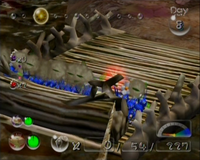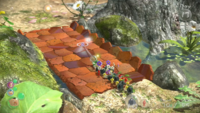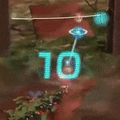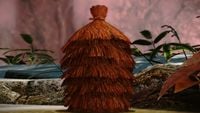User:Chazmatron/Bridge test
Stick Bridges
Stick bridges are bridges made of sticks found in Pikmin and Pikmin 2. These are the only type of bridge to appear in the first two games, as they are replaced with fragment bridges in Pikmin 3 and Hey! Pikmin, and clay bridges in Pikmin 4. These bridges are often used as pathways across large bodies of water, making them excellent shortcuts.
Stick bridges are found as piles of sticks and require Pikmin to construct them. Sending Pikmin on the bridge causes them to use the piles of sticks to construct the bridge. The bridge will be constructed in chunks at intervals, marked with a cloud of dust. The more Pikmin constructing the bridge increases the speed of which the bridge is built.
Cloaking Burrow-nit and members of the Mandiblard family will chew apart these bridges and progressively deconstruct them in intervals, similar to how it's built. If they manage to fully deconstruct the bridge, then all that remains is the pile of sticks in their original location before the bridge was constructed. In Pikmin 2, bridges will only take the usual time to build if it is the first time the player is on the area. If the player goes to the area again on a later day, or simply goes inside a cave and comes back out, the bridge construction progresses from one checkpoint to the next instantly, with the only delay being the time it takes for the clouds to dissipate and for the Pikmin to move to the next pile. Members of the Burrow-nit family and the Mandiblard family no longer destroy bridges in future Pikmin instalments as they are made out of fragments and hardened clay.
Also in this game, if a Pikmin attacking a bridge is pushed to either side of the pile, it can cling on to the bridge and attack that way, instead of striking whilst standing up. If this happens, it will attack more frequently than usual, allowing bridges to be built faster. [1].
Additionally, one stick bridge in Pikmin 2 will be surrounded by poison emitters, similar to certain bramble gates, meaning that White Pikmin are initially required due to their poison immunity. Once the bridge is constructed slightly, the emitters will be revealed and can be destroyed by White Pikmin, allowing all other Pikmin to start constructing the bridge.
Locations
Gallery
Pikmin
A stick bridge in The Forest of Hope, being attacked by multiple Sheargrubs.
Another stick bridge in The Forest of Hope that is connected to the island where the Sagittarius is originally located.
A fully constructed stick bridge in The Forest Navel.
The two stick bridges at The Distant Spring that face one another, fully built.
One of the stick bridges in The Distant Spring, being attacked by a couple of Shearwigs.
One of the two stick bridges present in The Final Trial.
Another image of the bridge, but with the Secret Safe being carried across it.
Screenshot of the two-sectioned bridge glitch.
A stick bridge seen in one of Olimar's monologs.
Pikmin 2
The non-sloped stick bridge in the Valley of Repose.
An unbuilt stick bridge in the Awakening Wood, behind the poison white bramble gate.
The same bridge in the Awakening Wood being furled back up due to some Sheargrubs.
Some Burgeoning Spiderwort berries.
A Cloaking Burrow-nit destroying the only bridge in the Wistful Wild.
Names in other languages
Bridge
| Language | Name | Meaning | Notes |
|---|---|---|---|
| 橋? Hashi |
Bridge | ||
| Pont | Bridge | ||
| Ponte | Bridge | Translation taken from the Pikmin instruction manual. | |
| Puente | Bridge |
Sloped bridge
| Language | Name | Meaning |
|---|---|---|
| スロープ? Surōpu |
Slope |
See also
References
- ^ YouTube video showing the difference in speed between a standing attacking Pikmin and a clinging attacking Pikmin
| Tools |
|---|
|
|
| Minor tools |
Fragment Bridges
Fragment bridges are bridges (or pots) created by fragments in Pikmin 3 and Hey! Pikmin. These bridges come in a multitude of colors and sizes (in Pikmin 3, the shortest bridge is made out of 30 fragments, and the longest bridge is made out of 84 fragments) with some being partially or fully built.
Depending on the bridge, it may be possible for leaders and Pikmin to be thrown across and to the other side (an example where this isn't possible is the cyan-colored fragment bridge in the Twilight River that connects to the Winged Onion's section in Pikmin 3).
For a bridge to be built, Pikmin will need to carry fragments over to it and place them. Once all fragments are placed, the bridge will be completed. Unlike the stick bridges found in Pikmin and Pikmin 2, these fragment bridges are made out of a hard material, meaning enemies cannot destroy them.
In Pikmin 3, unfinished bridges are slightly slanted upwards, and an invisible wall will prevent leaders from crossing past the last existing row of six fragments. In addition, a bridge lowers into place when it is completed, which can knock leaders over if they are standing too close. Leaders on the bridge itself will not be knocked down.
Fragments
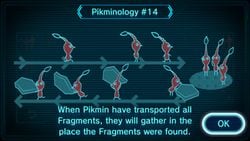
Fragments are tiles of broken household objects that are used to build the bridges in Pikmin 3 and Hey! Pikmin. Fragments are clustered together in piles, and the Pikmin will carry them to the bridge of the corresponding fragment color. This means each bridge has its own color and that fragments from one color cannot be used to build a bridge of a different one. Many of the fragments actually come from nearby broken pots, cups, glasses, and other modern-day objects.
Each bridge can have one or more piles of fragments. Fragments are also occasionally buried in dirt-mounds or encased inside large crystals. Additionally, in one case, in the Garden of Hope, fragments are used to build an overturned plant pot, not a bridge. When it is finished, it is used as a platform to throw leaders and Pikmin across. It's worth noting that even though Winged Pikmin can't reach submerged fragments of the pot, they can still build it underwater by carrying non-submerged fragments over and tossing them to where they belong.
In Pikmin 3, Pikmin will run back to the pile of fragments they were assigned to and take another piece. They will even return if there aren't any fragments left. However, if a Pikmin carrying a fragment is called back, that fragment will vanish and reappear at the pile it came from. This also happens for the Dawn Pustules, Dusk Pustules, and Burgeoning Spiderwort
Pikmin carrying fragments can also be pushed in this game, making them go faster. Each bridge is made out of a certain number of fragments (brown bridges are made of 30, red and blue of 60, and light blue of 84). Fragments are placed in rows of six, and any given row must be completed before the next row may be started – this is most noticeable when a large group of Pikmin carrying fragments arrives at the same time.
Locations
Gallery
Pikmin 3
- Bridge
The brown fragment bridge seen in the Tropical Wilds.
One of the two blue fragment bridges in the Garden of Hope.
The red and blue fragment bridges in the Distant Tundra nearby complete.
The completed cyan fragment bridge in the Twilight River.
A red fragment bridge found in a Mission Mode stage.
A hint featuring an unbuilt bridge.
Pikmin building a blue-fragmented bridge an early version of Pikmin 3.
A screenshot from a promotional video showcasing Alph on a fragment bridge.
Another screenshot from a promotion video showing the three leaders crossing a bridge.
A brown fragment bridge and the pot seen in the Wii U release of the Super Smash Bros. for Nintendo 3DS and Wii U.
- Fragments
A pile of brown bridge fragments seen in the Tropical Wilds.
A pile of brown bridge fragments found in the Garden of Hope.
A pile of red bridge fragments underneath a clipboard in the Twilight River.
Some cyan bridge fragments trapped inside of a crystal.
A hint featuring some bridge fragments.
Hey! Pikmin
Names in other languages
Fragment bridge
| Language | Name | Meaning |
|---|---|---|
| カケ橋? Kakehashi |
Makeshift bridge |
Fragments
| Language | Name | Meaning |
|---|---|---|
| カケラ (Pikmin 3) Kakera ガレキ (Hey! Pikmin) Gareki? |
Fragment Rubble | |
| Scherben | Shards | |
| Materiale | Material | |
| Fragmentos | Fragments |
See also
| Tools |
|---|
|
|
| Minor tools |
Hay
- "Hay" redirects here. For hay in Pikmin 4, see Dried plant.
Hay is a type of bridge only found in Pikmin 3. These bridges essentially replace the sloped stick bridges from the Pikmin and Pikmin 2. While the fragment bridges found in this game are made out of fragments and link two pieces of land over a gap, hay is grabbed in chunks and piled up against walls to serve as a ramp to go up. Additionally, unlike the fragment piles that are different quantities, each bundle of hay contains 30 pieces.
A large and tidy pile of hay sits in one place, and Pikmin grab chunks off of it, one by one, like fragments. When they reach the wall that needs to be overcome (which can be recognized with some faint strands of hay on the floor), they toss their hay on the floor, so that it piles up. When it's done, the "task complete" sound plays, and Pikmin and leaders can use the new ramp to climb up the wall.
These hay chunks function the same as fragments for bridges, as they can only be carried by Pikmin one at a time and Pikmin run back to the pile of fragments they were assigned to and take another piece. They will even return if there aren't any hay chunks left. Additionally, like fragments, Pikmin carrying hay chunks can be pushed, making them go faster.
Locations
Gallery
A bundle of hay found in the Distant Tundra.
A fully built hay pound in Big Fruit Carnival.
Names in other languages
Hay
| Language | Name | Meaning |
|---|---|---|
| シュロ? Shuro |
Trachycarpus |
